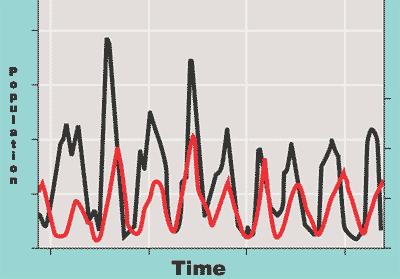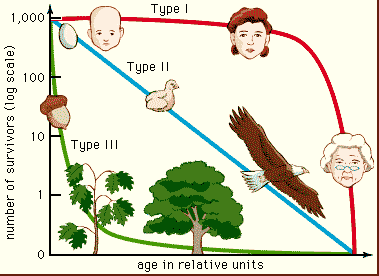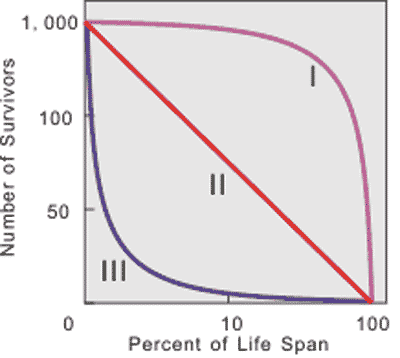| A | B |
|---|
| The movement of organisms into a given area from another area is called ____. | immigration p. 1172 |
| When organisms leave a certain area, the movement is called ___. | emigration p. 1172 |
| For a population to grow, the ____ must be bigger than the ____ | birthrate must be larger than the deathrate (assuming no immigration or emigration) p. 1176 |
| The number of individuals per unit area or volume is a population’s ____. | density p. 1171 |
| Logistic growth occurs when a population’s growth __________ , after a period of rapid growth. | slows down or stops p. 1177-1178 |
| Under ideal conditions with unlimited resources, a population will grow _____. | exponentially p. 1176 |
| The graph of exponential population growth is describes as a(n) _____-shaped curve. | J-shaped curve p. 1176 |
| The graph of logistical population growth is described as a(n) _____-shaped curve. | S-shaped curve p. 1178 |
Which type of population growth does this graph show?,  | Exponential growth (Can only happens under ideal conditions with unlimited space, food and no predators) p. 1176,  |
Which type of population growth does this graph show?,  | Logistic growth p. 1178,  |
At which point in the graph below is the population growth rate accelerating?,  | Point A (The graph line should be more curved in an upward direction. It looks a little too linear, but I had a hard time drawing it that way) p. 1178,  |
At which point in the graph below is the population growth rate the highest?,  | The population growth "rate" is the highest at point B. (You can determine the growth rate by finding the slope of the line tangent to the curve. Remember, slope = rise divided by run. In this case, the rise is the current population. The run is time. Dividing population by time gives you the population growth "rate.") p. 1178,  |
At which point in the graph below is the population growth rate starting to slow down?,  | Point C p. 1178,  |
At which point in the graph below is the population the highest?,  | The population is the highest at point D (look along the y-axis) p. 1178,  |
At which point on the graph below is the population growth rate the lowest?,  | The population growth rate is lowest at point D (notice that the population, even though it is at its highest, has stopped growing) p. 1178,  |
At which point in the graph below is the population at the carrying capacity?,  | The population has reached the carrying capacity at point D. Remember, the carrying capacity is the maximum number of individuals that the environment can support. p. 1178,  |
| _______ is the study of the vital statistics of populations and how they change over time. | Demography p. 1173 |
| What happened to human population growth around 1650 A.D.? | Human population started growing more rapidly. (It really started taking off in an exponential fashion around the start of the industrial revolution in the early 1800's) p. 1187 |
| In human populations, ____ is a change from high birth rates and high death rates to low birth rates and low death rates. | demographic transition p. 1188 |
| In human populations, the first stage of demographic transition is characterized by ___. | low death rate and high birth rate (Before the transition starts, you have high birth rates and high death rates. Third world countries start the demographic transition when health care and sanitation improve, decreasing the death rate) p. 1188 |
| In human populations, demographic transition begins changes in society that ___. | lower the death rate p. 1188 |
Which of these two age structure diagrams shows the typical human age structure of a typical third-world country?,  | A p. 1189,  |
Which of these two age structure diagrams shows the typical human age structure of a first world modernized country?,  | B p. 1189,  |
The age structure diagram on the left shows a ____ birth rate and a ____ death rate.,  | high birth rate and high death rate. p. 1189,  |
The age structure diagram on the right shows a ____ birth rate and a ____ death rate.,  | low birth rate and low death rate. p. 1189,  |
| _____ is the pattern of spacing among individuals within the boundaries of the population. | Dispersion p. 1171 |
| Which two techniques for estimating population size are most commonly used by scientists? Under what circumstances would you use each one? | The sample plot method is used when the organisms are unlikely to move much (like trees). The mark-recapture method is used when individuals move about frequently (like fish). p. 1171 and the masteringbiology.com activity called "Techniques for Estimating Population Density and Size " |
| What is a possible source of error that must be taken into consideration when using the mark-recapture method for estimating population size? | A potential source of error for the mark-recapture method is the possibility that already marked individuals may be less likely to be trapped again if they become wary of the traps, or more likely to be recaptured again if they realize they can get free food and be released unharmed. p. 1171 |
The graph below shows population fluctuation typical of a(n) _____ relationship.,  | predator-prey p. 1185,  |
Which country below is likely to experience a decline in population due to its age structure?,  | Italy. Notice the small percentage of young people in the population. As they reach child-baring age, the country's birth rate is likely to fall. Conversely, Afghanistan has a large proportion of its population in child-baring or soon to be child-baring age categories and will likely see rapid population growth unless war and famine cause the death rate to match the birth rate. p. 1189,  |
Which type of dispersion pattern is shown below and which factors may account for this type of dispersion?,  | Clumped dispersion. Communal living explains clumped dispersion in wolf populations. Other types of organisms may be clumped in particular microhabitats, such as fungi. The mating habits of certain insects may explain a swarm that clumps large numbers of individuals together. p. 1172,  |
Which type of dispersion pattern is shown below and which factors may account for this type of dispersion?,  | Uniform dispersion. Organisms that exhibit territoriality, or plants that give off chemicals to inhibit growth of neighboring plants often times have uniform distribution. p. 1172,  |
Which type of dispersion pattern is shown below and which factors may account for this type of dispersion?,  | Random dispersion. Occurs in the absence of strong attraction or repulsion among individuals in the population or a uniform environment. In this case, the dandelions seeds were blown randomly across the field. p. 1173,  |
| A life history in which adults produce large numbers of offspring over many years is called _____ or ______. | iteroparity (or repeated reproduction) p. 1180 |
| The study of how complex interactions between biotic and abiotic factors influence variations in population size. | population dynamics p. 1184 |
| A plot of the number of members of a cohort that are still alive at each age. One way to graphically represent age-specific mortality. | survivorship curve p. 1173,  |
Which survivorship curve would represent the human species? Which would represent a typical fish species?,  | Humans would be type I due to their fairly high infant survival rate. Fish would be type III because most lay many eggs and generally don't guard them or protect the juveniles, so most fish are eaten when they are small, if they even manage to make it out of their egg. p. 1174,  |
| Selection that favors life history traits that maximize reproduction in uncrowded environments are called ____ selection or density-____. | r-selection or density-independent selection p. 1181 |
| Selection that favors life-history traits that allow for survival under crowded competitive conditions is known as ____ selection or density-____. | K-selection or density-dependent selection p. 1181 |
| A period of stability in population size, when the per capita birth rate and death rate are equal. | Zero population growth (ZPG) p. 1176 |
| The maximum population size that can be supported by the available resources, symbolized as K. | carrying capacity p. 1177 |
| The amount of land required by a person, city, or nation to support their needs, including food production, water acquisition, and waste disposal.. | ecological footprint p. 1190 |
| A typical person in a modern industrialized country like the U.S. uses about ____ times as much energy as the average person in Central Africa does. | 30 times (This is due to the fact that people in wealthier countries buy a lot of stuff. Stuff requires a lot of energy to manufacture and get to the store) p. 1190 |
| A group of populations that are linked due to high rates of emigration and immigration. | meta-population p. 1186 |
| The study of populations in relation to the environment, including environmental influences on population density and distribution, age structure, and variations in population size. | population ecology p. 1170 |
| A dispersion pattern in which individuals are aggregated in patches. | clumped dispersion p. 1172 |
| Referring to any characteristic that varies according to an increase in population density. | density-dependent p. 1182 |
| A model describing population growth that levels off as population size approaches carrying capacity. | logistic population growth p. 1177 |
| A behavior in which an animal defends a bounded physical space against encroachment by other individuals, usually of its own species. | territoriality p. 1172 |
| A(n) ______ is group of individuals of the same age that are studied for a long period of time. | cohort p. 1173 |
| A(n) ______ table is an age-specific summary of the survival pattern of a population. | life table p. 1173 |
| A life history in which adults have but a single reproductive opportunity to produce large numbers of offspring is called _____ or ______. | semelparity (or big-bang reproduction) p. 1180 |
| The number of infant deaths per 1,000 live births is referred to as _____. | infant mortality p. 1189 |
| Referring to any characteristic that is not affected by population density. | density-independent p. 1182 |
| The relative number of individuals of each age in a population is known as the population's _____. | age structure p. 1188 |
| Disease is a density-_____ factor that limits population growth. | density-dependent p. 1182 |
| Harsh winters would be considered as density-______ factors that limit population growth. | density-independent p. 1182 |
| Situations in which a population that is too small makes it harder for the remaining individuals to survive, such as a lone tree now exposed to high winds, or an animal that has a hard time finding a mate, is called the ____ effect. | Allee effect p. 1178 |
| A(n) _______ is a group of individuals of a single species living in the same general area. | population p. 1170 |
| A(n) _____ table is an age-specific summary of the reproductive rates in a population showing how those reproductive rates change as females get older. | reproductive table p. 1174 |
| Exponential population growth is also known as _______ population growth. | geometric p. 1176 |
| Geometric population growth is also known as _______ population growth. | exponential p. 1176 |
| Which type of life history reproductive strategy (semelparity or iteroparity) would be favored in highly variable, unpredictable environments? | Semelparity (In unpredictable environments, the odds that the offspring live, or even that the parent lives long enough to reproduce more than once, are lower, so it makes evolutionary sense to reproduce as many offspring as possible in the "one-shot" pattern of big-bang reproduction that is known as semelparity) p. 1180 |
| Which type of life history reproductive strategy (semelparity or iteroparity) would be favored in stable, predictable environments? | Iteroparity (In predictable environments, parents are more likely to be able to survive and reproduce again, but competition for resources is fierce since the population is likely to be close to carrying capacity. Therefore, it is a better strategy to have fewer offspring and put more energy into taking care of them, or making fewer but larger eggs with more nutrients so the offspring are larger and better able to take care of themselves at birth) p. 1180 |
The ________ refers to a period of time immediately after World War II, where more people were born than average because couples held off having children during the war (because many of the males in the United States were overseas fighting). Because of this, there is a bulge in the age structure diagram of the United States in the age groups now nearing retirement age (see diagram below). This is one of the main reasons our social security program is in trouble, as many people are going to start collecting social security without the large numbers of younger working people to pay the taxes that have historically supported the payment of social security and health care to retired people. Another problem is that people are living longer and longer after retirement.,  | baby boom p. 1188,  |
| In countries where infant mortality is _____, parents are likely to have more children. | high (They do this in order to ensure that at least some children will survive. Infant mortality tends to be high in poorer countries, which is why birth-rates tend to be high in poorer countries. Most poorer countries don't have social security systems to take care of old people, so if you don't have children to help take care of you in your old age, you are pretty much on your own) p. 1189 |
| What is the current human population of the planet (to the nearest billion)? | 7 billion (The book says 6.8 billion, but since this book was published, it has gone over 7 billion. This is pretty scary considering that when Mr. McGee was your age, there were only about 4.5 billion people on the planet) p. 1187 |
| The word root "co-" means ___. | co- = together (cohort: a group of individuals of the same age, from birth until all are dead) |